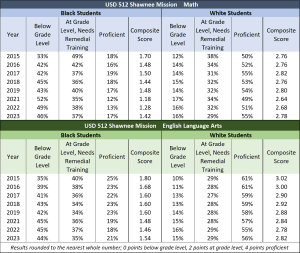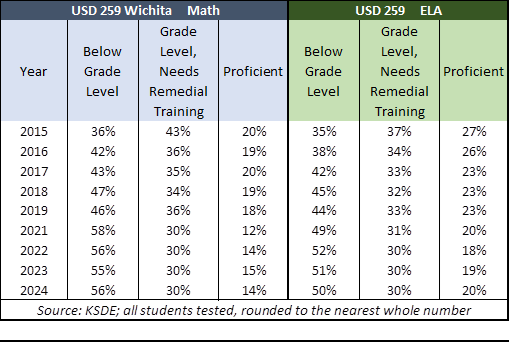Achievement gaps in math and English Language Arts are worse for minorities and low-income students in the three largest school districts in Johnson County on the state assessment, despite large funding increases to help at-risk students. At the same time, each school district implemented diversity, equity, and inclusion (DEI) training, theoretically to improve minority outcomes. Sadly, those gaps also expanded.
In most cases, results for 2023 are lower than in 2015 (the first year of the current assessment). Each school district and student group examined saw results decline between 2015 and 2019, and the 2023 outcomes in the majority of the comparisons are also than in 2019, so the declines cannot be blamed on the pandemic.
It’s also not because minorities and low-income students are incapable of learning but that these students have not had the same opportunities.
There are four levels of state assessment scores. Level 1 is below grade level, Level 2 is at grade level but needs remedial training, and Levels 3 and 4 are proficient. Measuring trends in achievement gaps with three moving variables is difficult, so we convert outcomes to a single score.

We apply zero points to Below Grade Level, two points for At Grade Level, and four points for Proficient. The scores are weighted according to the share of students in each category, as shown in this example. Two points times 35% (At Grade Level) is a score of 0.70, plus four points times 30% (Proficient) produces a composite score of 1.90.
This table shows the math and English Language Arts (ELA) scores for low-income students and those who are not low-income in Shawnee Mission for each year the current state assessment has been administered. Both demographic groups have more students below grade level now than in 2015 in math and ELA. Math proficiency is two points lower for low-income students but five points higher for their more affluent peers. In ELA, both demographic groups fell; six points for low-income students and five points for those who are not low-income.

Low-income students had a 1.92 math composite score in 2015, compared to 2.80 for other students, putting the gap at 0.88. Now, the gap is wider at 1.120, with low-income students falling to a 1.64 composite and the other group at 2.84. The ELA gap widened from 1.04 to 1.18.
Overall, results for both student groups are lower than pre-pandemic levels in 2019, which had declined from 2015.
USD 512 Shawnee Mission, as well as Blue Valley and Olathe, is preoccupied with diversity, equity, and inclusion (DEI), the premise of which is that making minority students feel more welcomed would improve outcomes and close achievement gaps. Instead, outcomes are worse, and the gaps are wider.
Black students have a much lower math composite score, driven mostly by the percentage of students below grade level going from 33% to 46%. The composite for White students improved, resulting in the achievement gap going from 1.06 to 1.36. The ELA achievement gap is also worse; both cohorts scored lower than in 2015, but Black students dropped more than White students.

Outcomes and achievement gaps for Hispanic students are also worse in math and ELA. White students have slightly better outcomes since 2015 in Math, but Hispanic students did worse, pushing the achievement gap from 0.90 to 1.24. Both cohorts have lower ELA outcomes, but Hispanic students declined more than White students.

USD 229 Blue Valley achievement gaps are worse
Income-based achievement gaps are also worse in USD 229 Blue Valley. Both cohorts have lower outcomes, but the low-income students dropped more than their more affluent peers.

The same situation applies to the comparison of Black and White students. Outcomes are lower for both groups of students, but achievement for Black students dropped more than did White students.

The math achievement gap for Hispanic students is worse. Both cohorts declined, but Hispanic students dropped more than White students.
The ELA gap narrowed a bit, but only because outcomes for White students declined more than did Hispanic students. The Hispanic composite fell 0.32 points, from 2.78 to 2.46, while White students dropped 0.34 points.

USD 233 Olathe achievement gaps widen
Both income-based student groups in USD 233 Olathe have lower performance in 2023 than in 2015 in math and ELA, but the low-income students had steeper declines and caused the achievement gaps to widen.

The math achievement gap is slightly smaller for Black students, but only because White students’ performance declined more than did Black students (0.08 vs 0.10).

The gaps grew worse for Hispanic students in both subjects, with both student groups declining, but White students dropped less than did Hispanic students.







